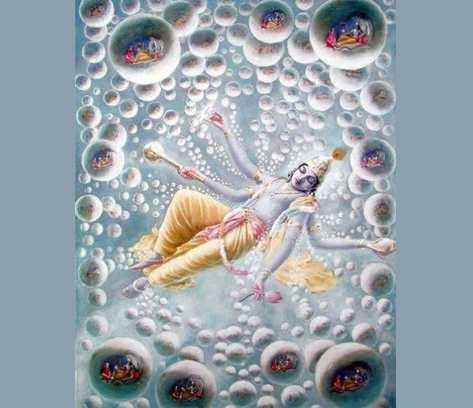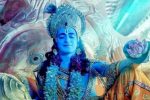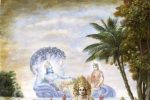NAME 88
Viśvaretāḥ विश्वरेताः
Viśvaretas means the seed of the universe. Viśva literally means universal and retas means seed. Kṛṣṇa beautifully explains this in Bhagavad Gita (XIV.4), “Of all embodied beings, Prakṛti is the Mother, who conceives and I am the seed giving Father.”
According to Sāṃkhya philosophy, there are two primary aspects of creation. One is the Puruṣa, the masculine energy and another is Prakṛti, the feminine energy. The conjugation between the two causes creation of the universe. Individual puruṣa, which is also known as the individual soul when unites with Prakṛti, an individual being is born.
This nāma says that Viṣṇu is that Puruṣa, the Brahman. He is the seed of the Universe
Vishva means Universe, Retas means seed. He is the seed Cause for the Universe and also the Universal Cause.
The word basis can be interpreted as ‘Vishvam Kaaryam asya asti iti’ or ‘Vishvasya Karanatvaat’. He is the Cause and the Universe is the result. If the Universe can be compared to a tree, He is the seed for that tree!
Needless to say Creation does not diminish the prowess of Bhagavan in any way because as the Upanishads say ‘Poornasya Poornam Aadaaya Poornameva Avashishyate- He remains perfect even after creating the perfect Universe’.
Sri Parasara Bhattar notes that the purpose of His creation (or the Purushartha) is for His service and His service alone.
BG 14.1:
श्रीभगवानुवाच |
परं भूय: प्रवक्ष्यामि ज्ञानानां ज्ञानमुत्तमम् |
यज्ज्ञात्वा मुनय: सर्वे परां सिद्धिमितो गता: || 1||
śhrī-bhagavān uvācha
paraṁ bhūyaḥ pravakṣhyāmi jñānānāṁ jñānam uttamam
yaj jñātvā munayaḥ sarve parāṁ siddhim ito gatāḥ
BG 14.1: The Divine Lord said: I shall once again explain to you the supreme wisdom, the best of all knowledge; by knowing which, all the great saints attained the highest perfection.
In the previous chapter, Shree Krishna had explained that all life forms are a combination of soul and matter. He had also elucidated that prakṛiti (material nature) is responsible for creating the field of activities for the puruṣh (soul). He added that this does not happen independently, but under the direction of the Supreme Lord, who is also seated within the body of the living being. In this chapter, he goes on to elaborate in detail about the three-fold qualities of material nature (the guṇas). By gaining this knowledge and imbibing it into our consciousness as realized wisdom, we can ascend to the highest perfection.
८८. ॐ विश्वरेतसे नमः |
88. OM Viśvaretase Namaḥ
Visvaretaah -Retas means ‘seed’; the term connotes that He is the seed from which the tree of life has sprung forth. He who is the very cause for the entire play of experience in the world of pluralistic objects (Sarva- Prapancha-Kaaranabhootah) is called Visvaretaah.
Viśvasya kāraṇatvena viśvaretā janārdhanaḥ / विश्वस्य कारणत्वेन विश्वरेता जनार्धनः He is the seed of the Universe. As He is the cause (from retas) of the Universe, He is Viśvaretāh
Bhagavad Gītā – Chapter 14
Sarvayoniṣu kaunteya! mūrtayassambhavantiyāḥ,
Tāsāṃ brahma mahadyoni rahaṃ bījapradaḥ pitā. (4)
:: श्रीमद्भगवद् गीता – गुणत्रय विभाग योग ::
सर्वयोनिषु कौन्तेय! मूर्तयस्सम्भवन्तियाः ।
तासां ब्रह्म महद्योनि रहं बीजप्रदः पिता ॥ ४ ॥
O Son of Kuntī (Arjunā), of all forms produced from whatsoever wombs – Great Prakr̥ti is the original womb (Mother), I am the seed-imparting Father.
INTERPRETATION GUIDED BY SANT VANI (WORDS OF SAINTS)
Viśvaretāḥ
The seed of the universe.
He is the seed for the entire jagat, He is viśvaretas. Parameśvara is the nimitta- kāraṇa, the efficient or the intelligent cause for this world – all that is known and unknown. When we say that Īśvara is the intelligent cause, it includes the material cause also. He is both the maker and the material.
Let’s consider the human zygote formed by the ovum and sperm, which goes onto become a full human body, sometimes even 7 ft tall. Can we categorically say that the zygote is the intelligent cause for the material product? Or can we say that the zygote is mini material cause for the big material product? None would be totally true. In the zygote is both the material cause and the intelligent cause which manifests as the human body. It does not just randomly assemble itself.
Even a random assemblage will still have a method of being put together which will still demand some intelligence, even if it is rudimentary. Intelligence can rest only in a conscious being.
Because of the orientation to localize Īśvara and consider the maker and material separate, it is important to highlight that where there is the material, any material, the intelligent cause is right there.In this word, Viśvaretāḥ, the maker, the nimitta-kāraṇa, is pointed out. The seed for all living beings is called retas and for the seed to germinate, a womb is required. The Lord himself is the seed as well as the womb and this is indicated by the name Viśvaretas.
He who is the ‘seed’ of the Universe (Śaṅkara). From whom emerge the mind, sense organs, life, and the various mental states of the living beings. The seven sense organs emanate from him {Two eyes, two nostrils, two ears & one mouth}(Parāsara Battar).
Parāsara Battar also quotes from the Viṣhṇu–Tattva: “This wonderful wealth, namely the body with its limbs has been created for the purpose of serving that Supreme Being – Viṣhṇu.
Retāḥ means ‘seed’ and clearly this name is a reference to the fact that the Supreme Being is the seed from which the tree of life has sprung forth. We are rooted to the Supreme Being – he is our source but caught as we are in the world of experiences and plurality we do not see the reality of our true ‘source’.
This is also the reason why Viṣṇu is the consort of Bhūmā-Devi – he has given her his ‘seed’ which has resulted in the multiple manifestations and emanations we see. This is also why he keeps coming to save her from adharma and reset the needle of Dharma – his many avatāras are essentially to lessen the burden of Bhūmā-Devi.
This name also dovetails with the other three previous names in this string: Sureśa–Śaraṇaṃ–Śarma – he who is the supreme master and final refuge of all beings in the Universe is also ‘seed’ from which all life has sprung forth – Viśvaretāḥ.
In the 15th chapter (verses 1 & 2) of the Bhagavad gītā, a reference is made to that great tree of life – the Aswatta tree which strangely has its roots above and branches below, clearly an allegory to how we forget where our true roots are and instead indulge in the pleasures of the senses in the material plane of existence – these indulgences of course bear fruits that one can enjoy here and also in the hereafter but they do not necessarily help in breaking the cycle of birth-death-birth which is the true purpose of human life. Even the Devās enjoy their time in the ‘upper’ planes (worlds) of existence but even they are not really “free” and are still caught in the cycle of birth-death-birth.
PLEASE WATCH
For this to happen the aerial-adventitious roots that we have grown as a result of our desires driven by the Gunas that keep us connected to the material world need to be severed with the axe of discernment (Viveka) and then and only then can the search for the real root of each being begin and in finding the root lies our understanding the ‘seed’ of our existence and the purpose of life – Viśvaretāḥ
श्रीभगवानुवाच |
ऊर्ध्वमूलमध:शाखमश्वत्थं प्राहुरव्ययम् |
छन्दांसि यस्य पर्णानि यस्तं वेद स वेदवित् || 15-1||
śhrī-bhagavān uvācha
ūrdhva-mūlam adhaḥ-śhākham aśhvatthaṁ prāhur avyayam
chhandānsi yasya parṇāni yas taṁ veda sa veda-vit
अधश्चोर्ध्वं प्रसृतास्तस्य शाखा
गुणप्रवृद्धा विषयप्रवाला: |
अधश्च मूलान्यनुसन्ततानि
कर्मानुबन्धीनि मनुष्यलोके || 15-2||
adhaśh chordhvaṁ prasṛitās tasya śhākhā
guṇa-pravṛiddhā viṣhaya-pravālāḥ
adhaśh cha mūlāny anusantatāni
karmānubandhīni manuṣhya-loke
Sri Aurobindo in his Essays on the Gītā gives a masterly explanation on these verses of the Gītā that are relevant to this name of Viṣhṇu:
——–Selected Excerpts:
First there comes a description of cosmic existence in the Vedantic image of the aswattha tree. This tree of cosmic existence has no beginning and no end, space or in time; for it is eternal and imperishable, avyaya. The real form of it cannot be perceived by us in this material world of man’s embodiment, nor has it any apparent lasting foundation here; it is an infinite movement and its foundation is above in the supreme of the Infinite. Its principle is the ancient sempiternal urge to action, pravrtti, which for ever proceeds without beginning or end from the original Soul of all existence. Therefore its original source is above, beyond Time in the Eternal, but its branches stretch down below and it extends and plunges its other roots, well-fixed and clinging roots of attachment and desire with their consequences of more and more desire and an endlessly developing action, plunges them downward here into the world of men. The branches of this cosmic tree extend both below and above, below in the material, above in the supra-physical planes; they grow by the gunas of Nature, for the triple guna is all the subject of the Vedas, traigunya-visaya vedah.. The Vedic rhythms, chanda¯msi are the leaves and the sensible objects of desire supremely gained by a right doing of sacrifice are the constant budding of the foliage. Man, therefore, so long as he enjoys the play of the gunas and is attached to desire, is held in the coils of Pravritti, in the movement of birth and action, turns about constantly between the earth and the middle planes and the heavens and is unable to get back to his supreme spiritual infinitudes. This was perceived by the sages. To achieve liberation they followed the path of Nivritti or cessation from the original urge to action, and the consummation of this way is the cessation of birth itself and a transcendent status in the highest supracosmic reach of the Eternal. But for this purpose it is necessary to cut these long-fixed roots of desire by the strong sword of detachment and then to seek for that highest goal whence, once having reached it, there is no compulsion of return to mortal life. To be free from the bewilderment of this lower Maya, without egoism, the great fault of attachment conquered, all desires stilled, the duality of joy and grief cast away, always to be fixed in wide equality, always to be firm in a pure spiritual consciousness, these are the steps of the way to that supreme Infinite. There we find the timeless being which is not illumined by sun or moon or fire, but is itself the light of the presence of the eternal Purusha. I turn away, says the Vedantic verse, to seek that original Soul alone and to reach him in the great passage. That is the highest status of the Purushottama, his supra-cosmic existence.



